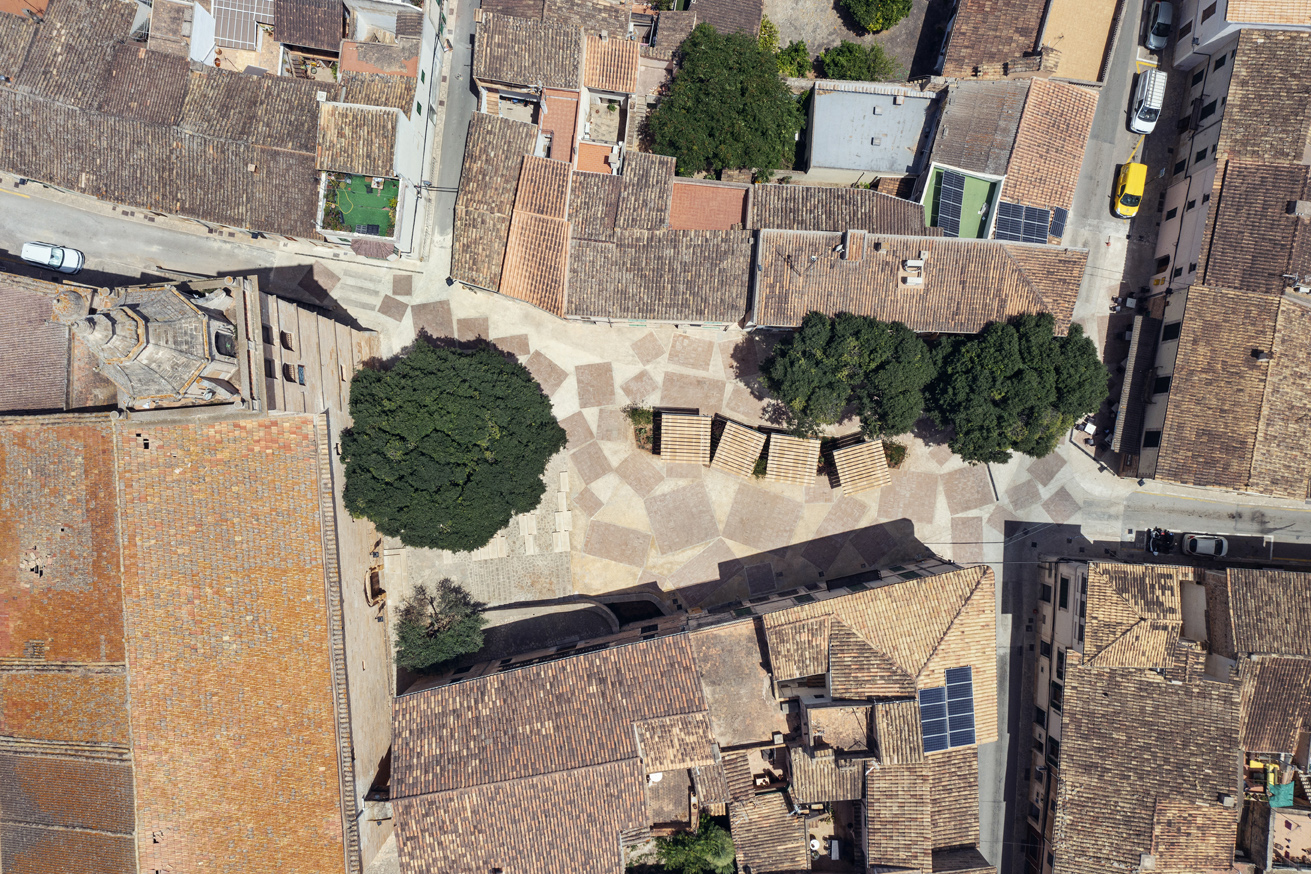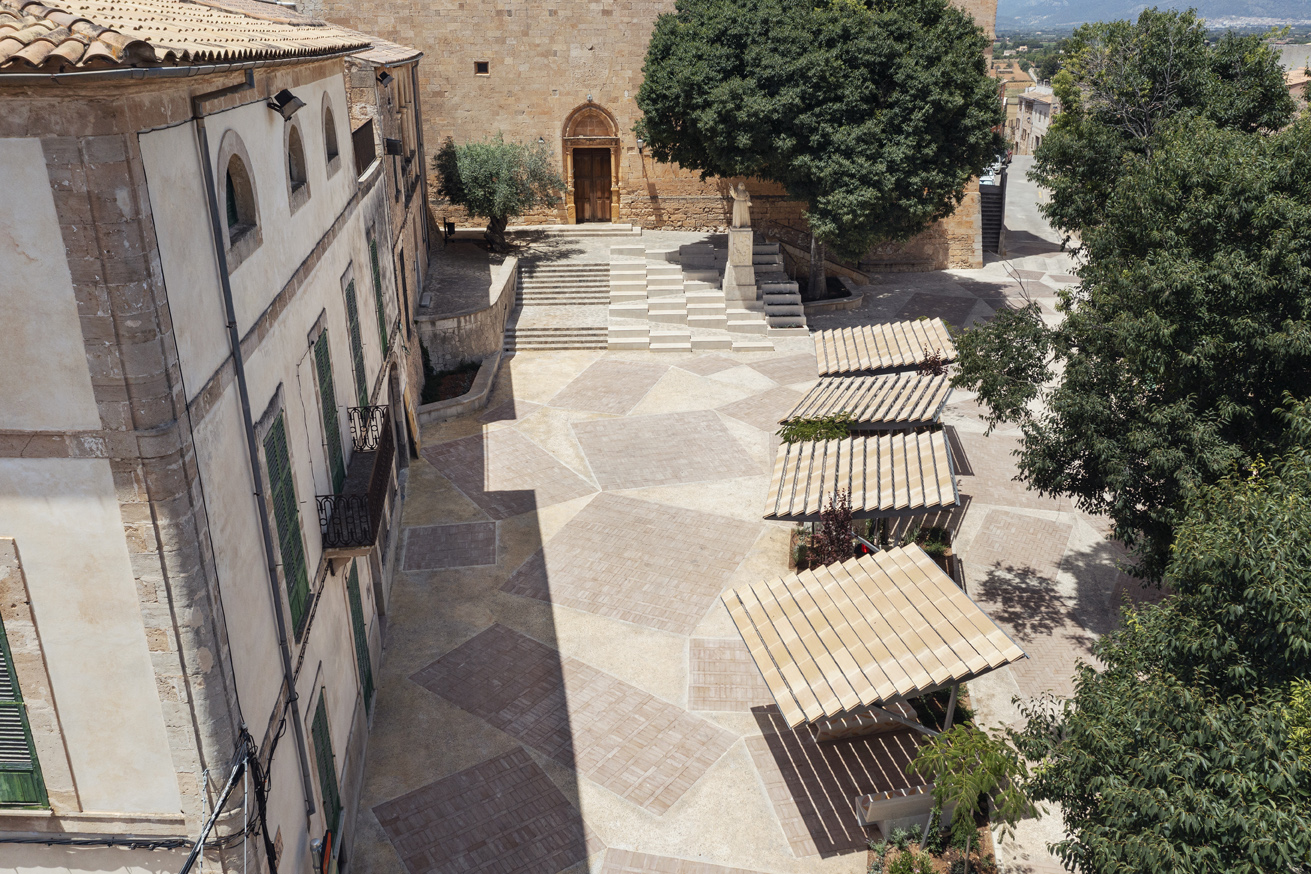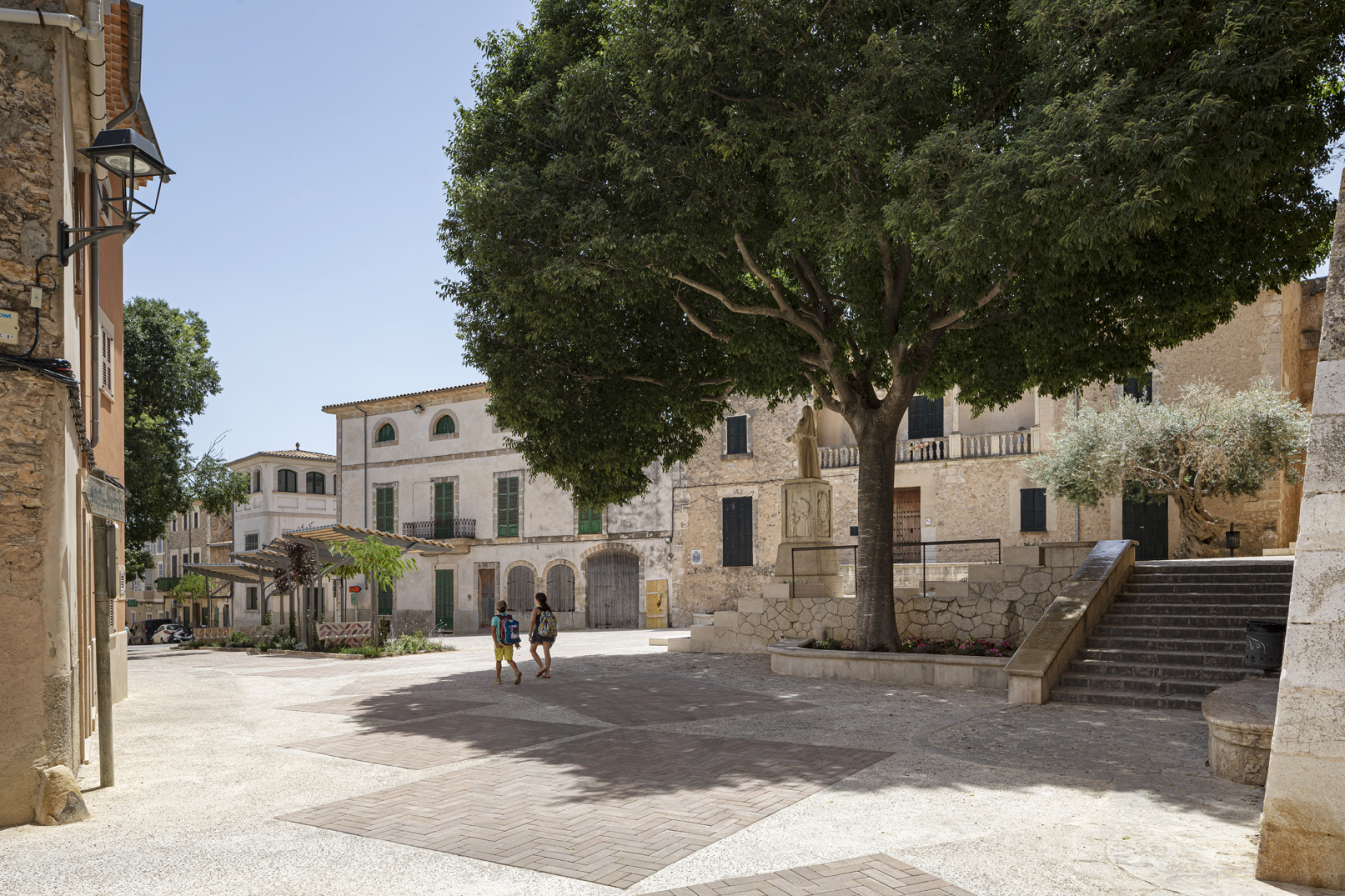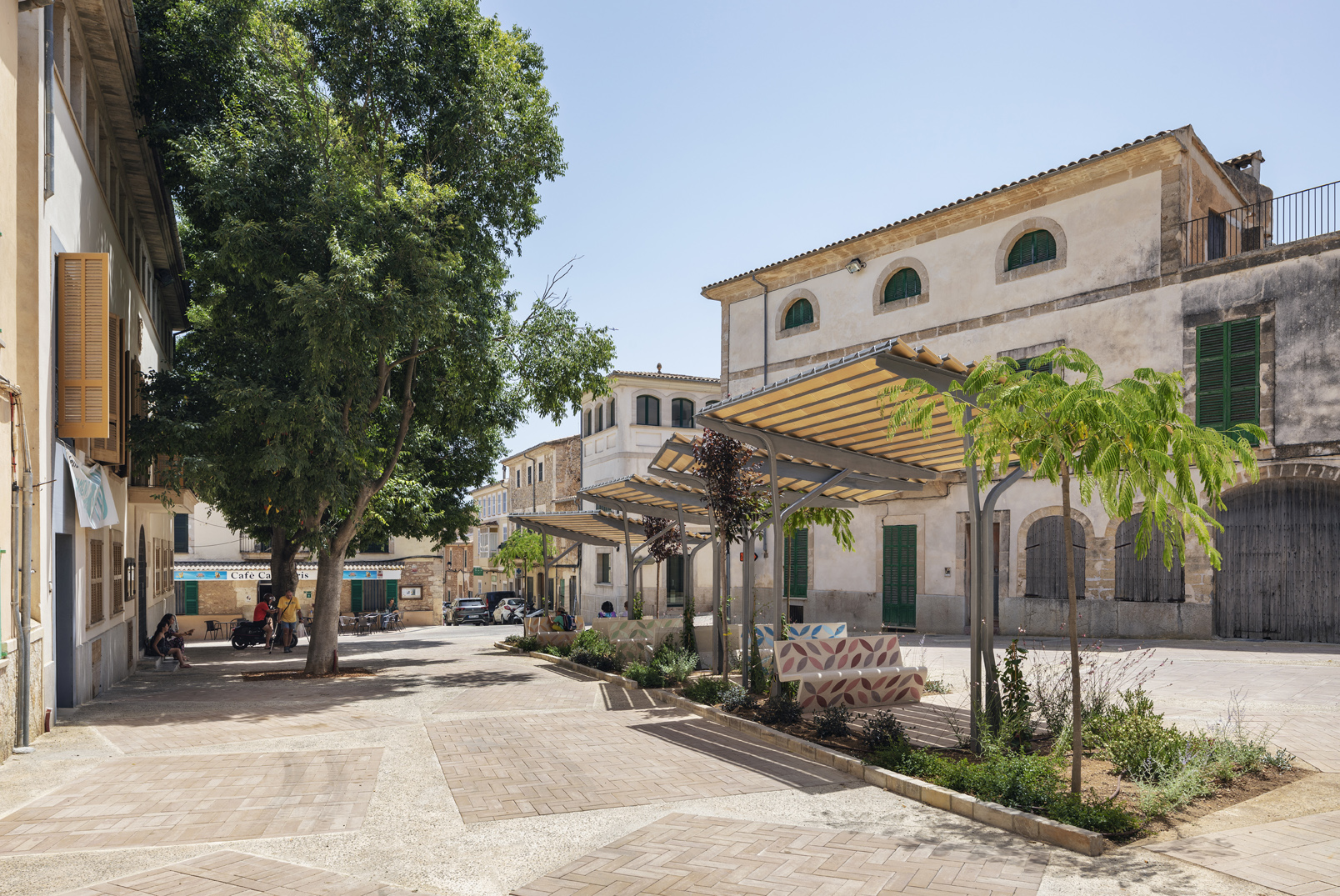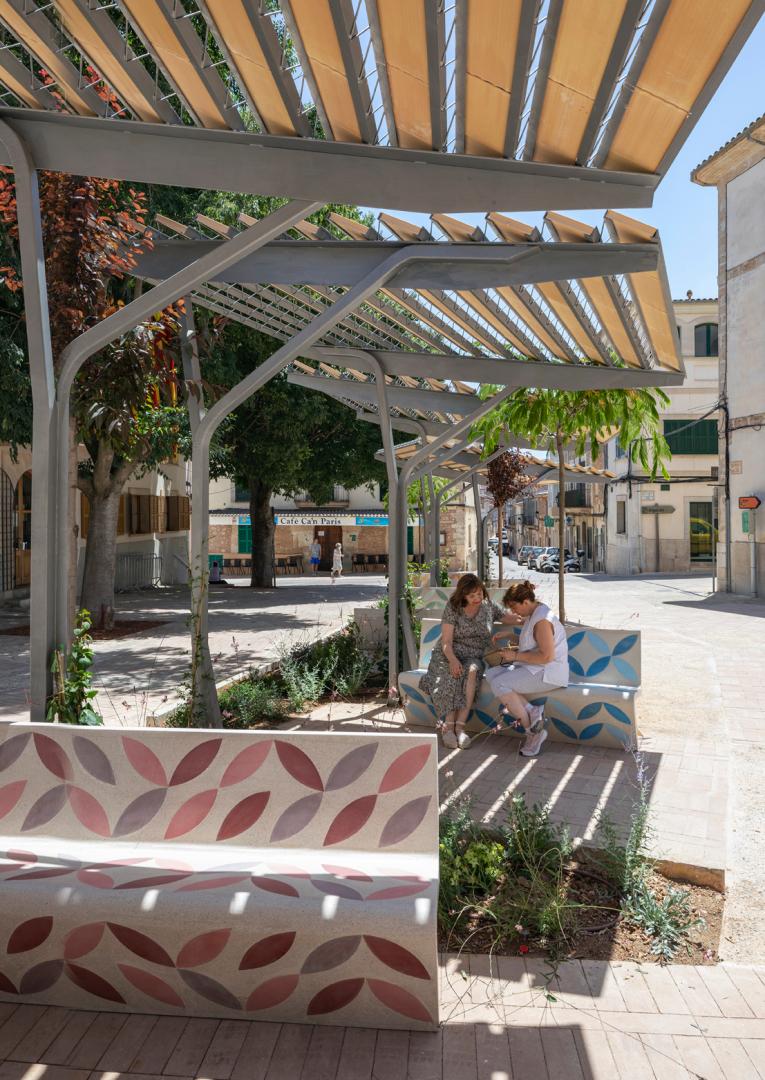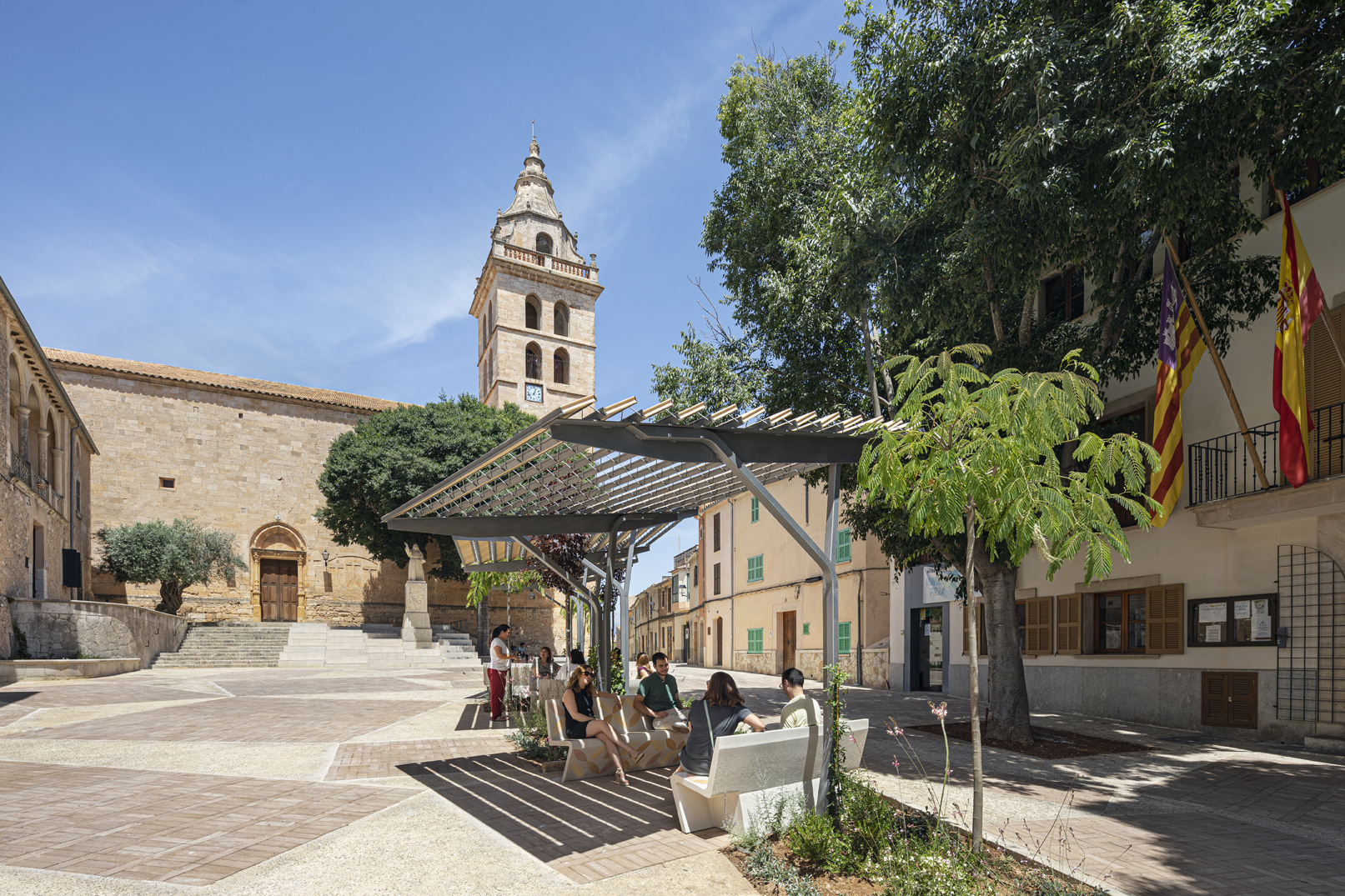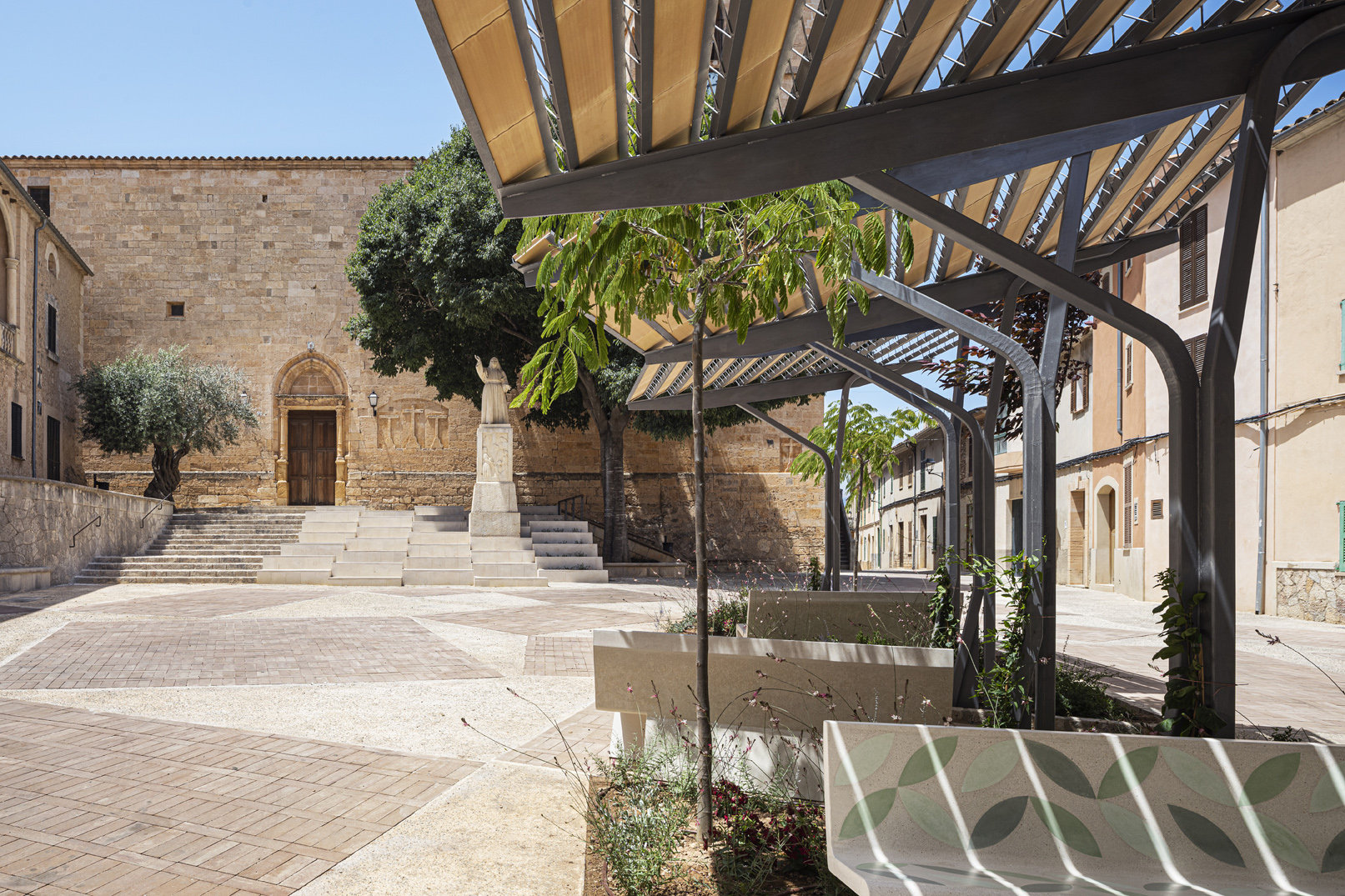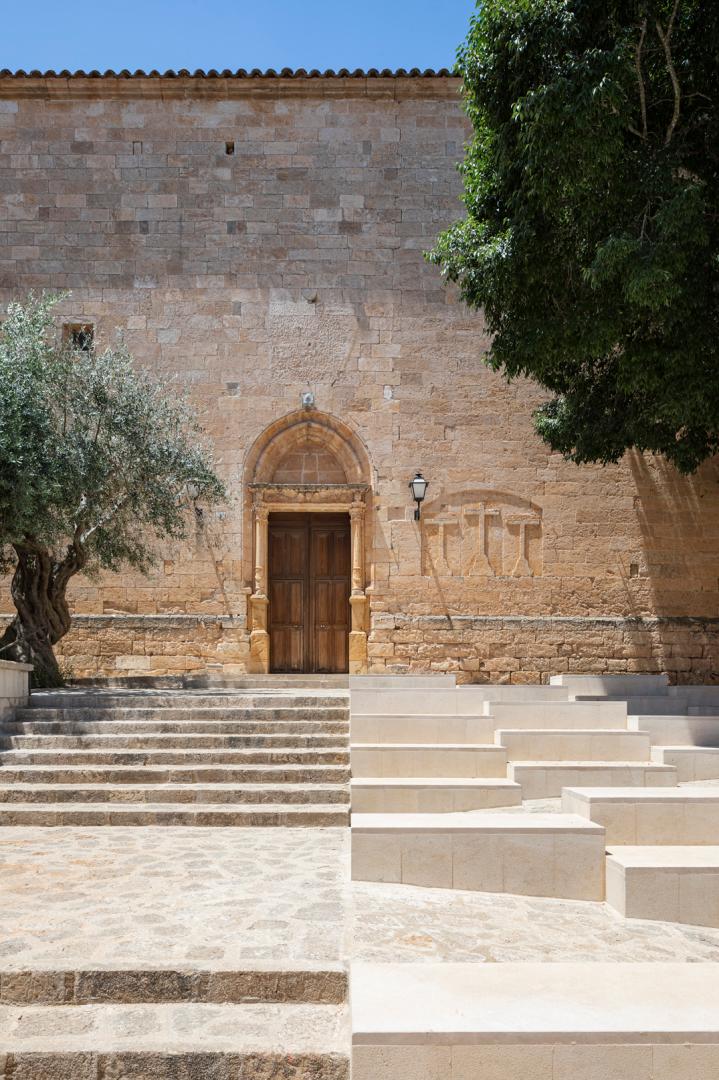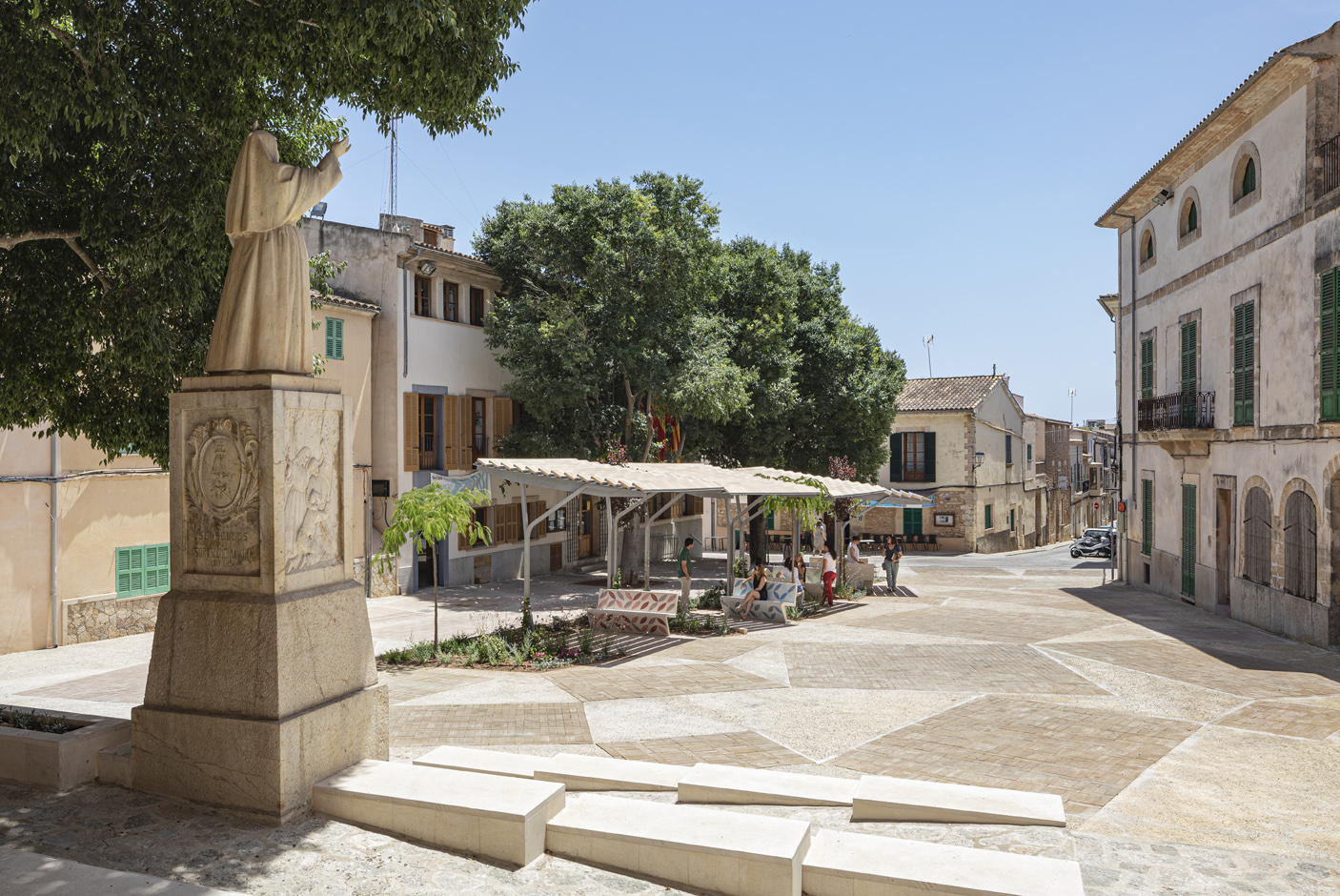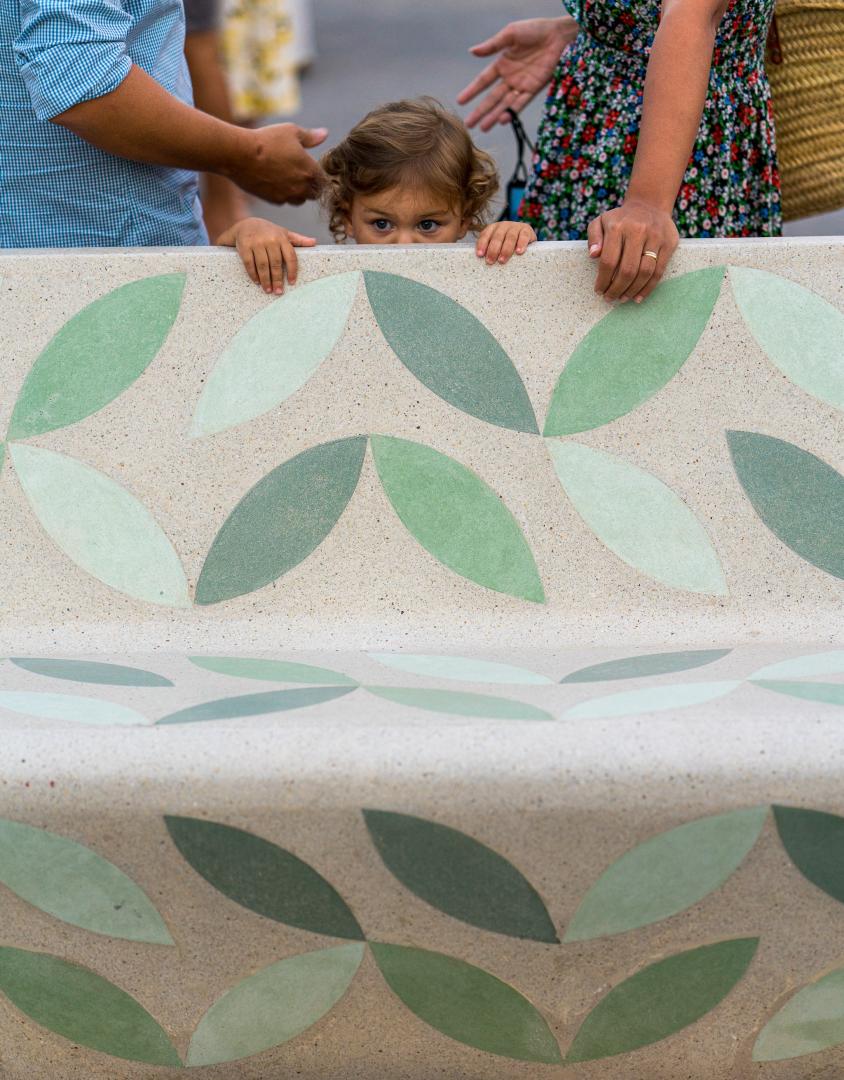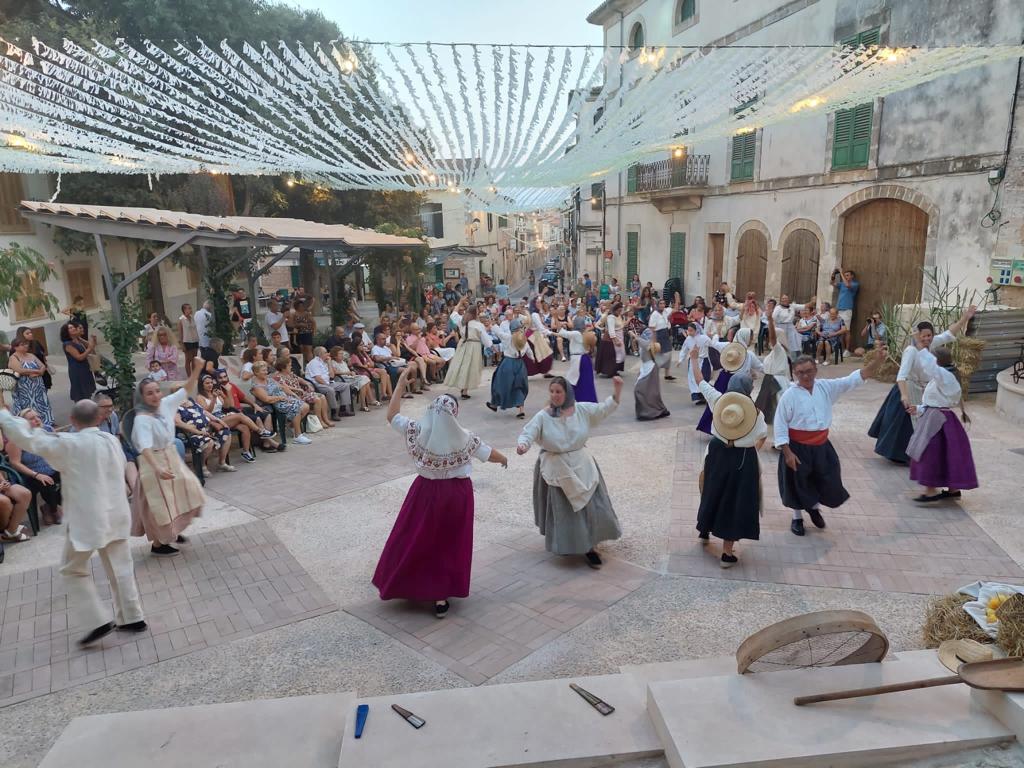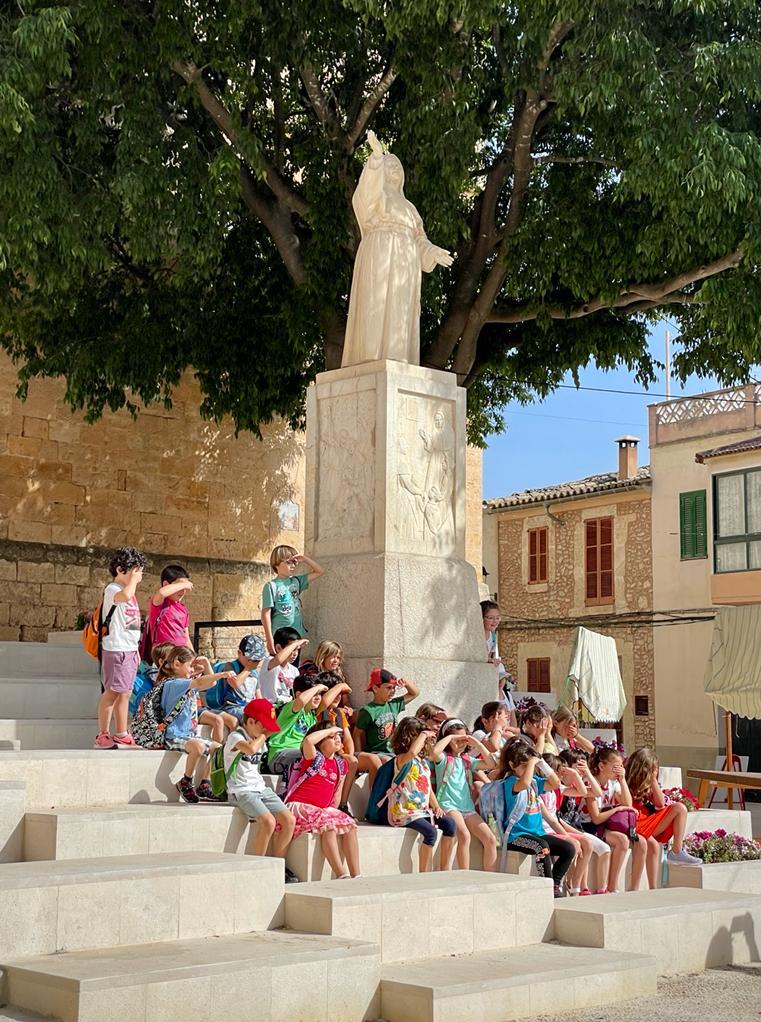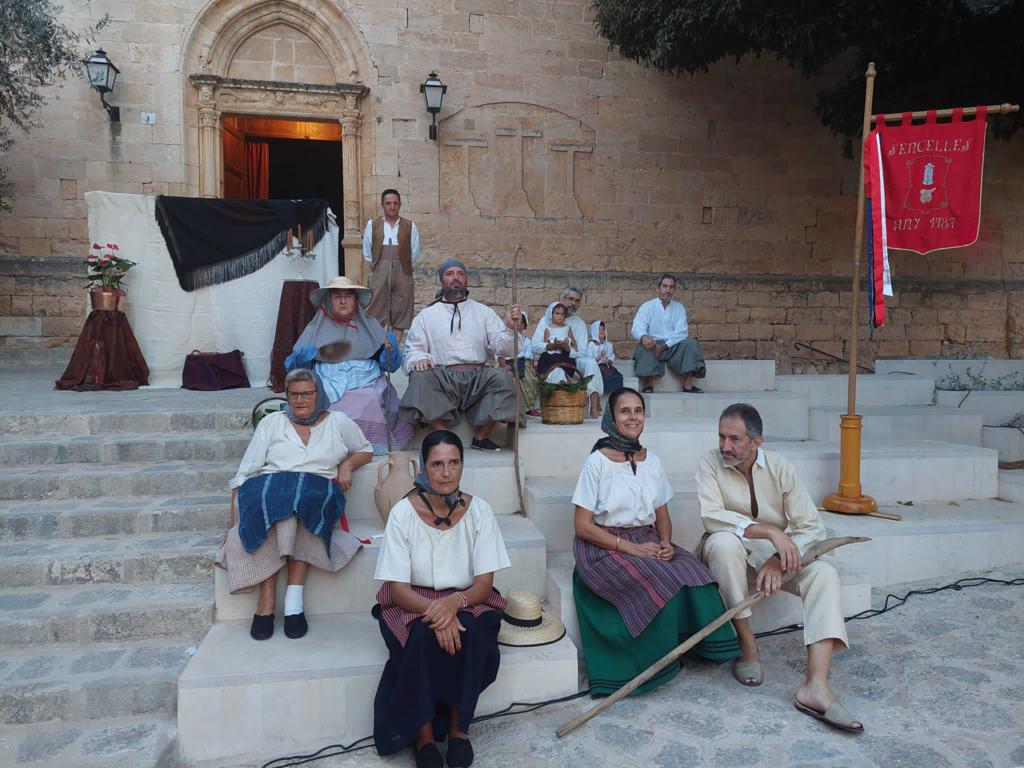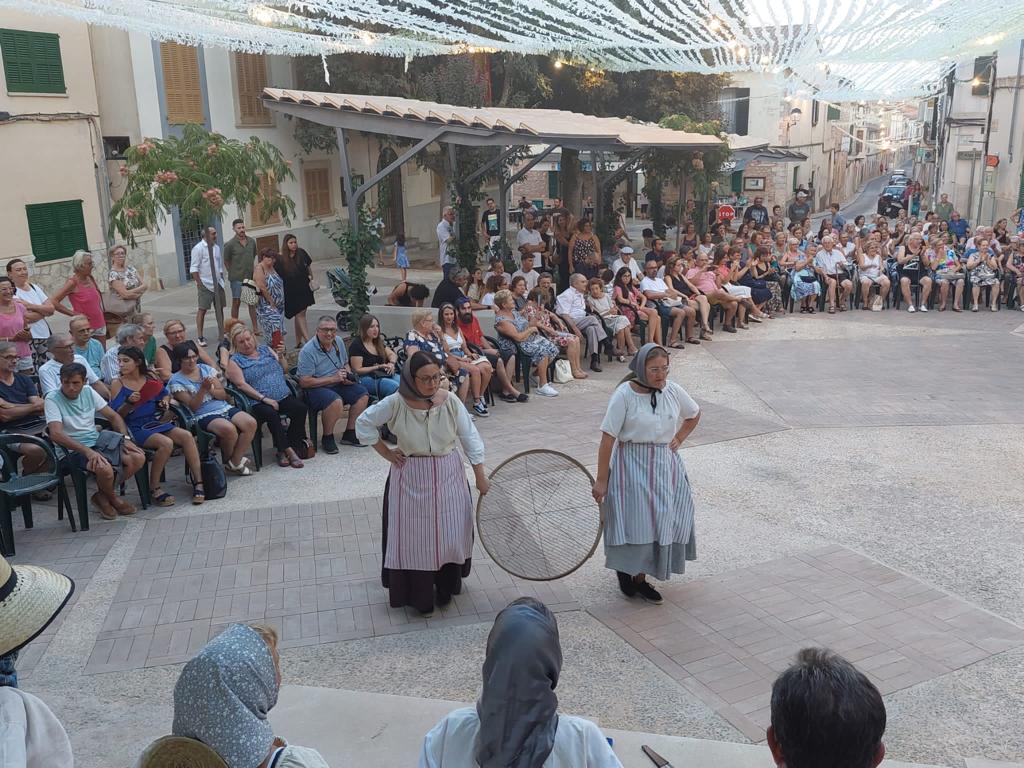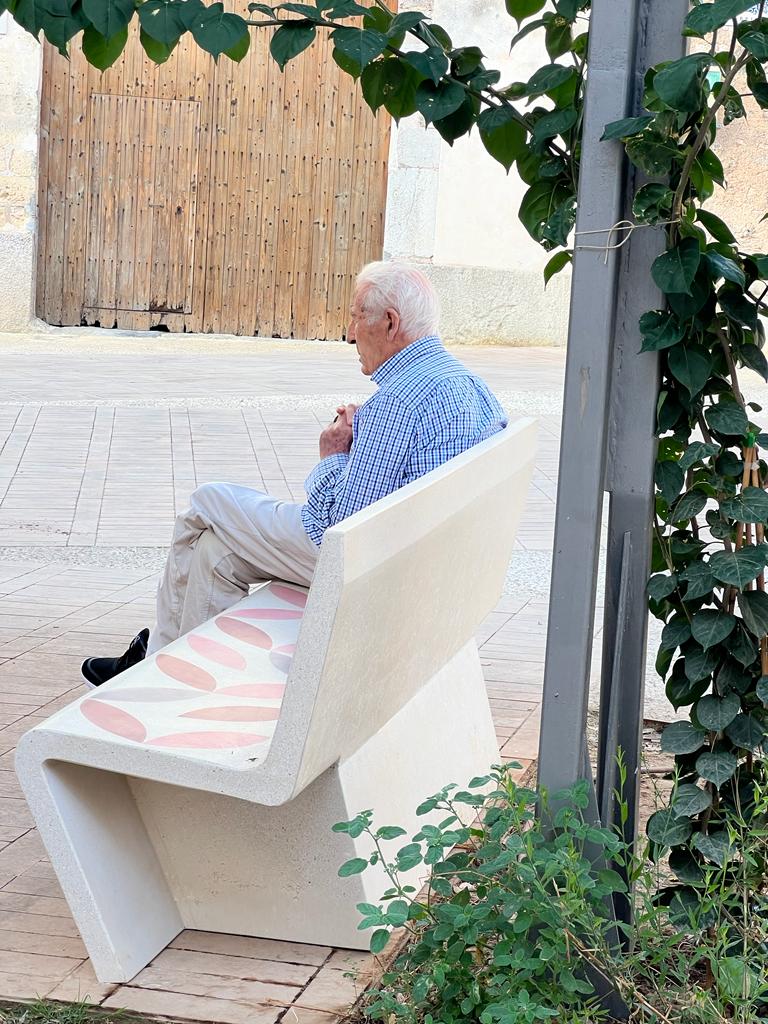Plaça de la Vila de Sencelles
Basic information
Project Title
Plaça de la Vila de Sencelles
Full project title
Reform and pedestrianization of the "Plaza de la Villa" of Sencelles
Category
Regaining a sense of belonging
Project Description
For decades, this public square in the Majorcan town of Sencelles was used as a parking lot. Our project recuperates the plaza as the town’s preeminent social space. With citizen participation, the plaza’s status as a venue for markets, dances, and processions was recovered. The design achieves universal access by incorporating a ramp between levels. By using local materials, it integrates easily with the historic townscape, and by adding shade structures and green space, it creates an oasis.
Geographical Scope
Local
Project Region
Sencelles, Spain
Urban or rural issues
Mainly urban
Physical or other transformations
It refers to a physical transformation of the built environment (hard investment)
EU Programme or fund
No
Description of the project
Summary
The project is located in the main Plaza de la Vila in the little town of Sencelles, an important space for the citizens, bordered by the Parish Church, the Town Hall, the post office and the local bar “Café Cán Paris”. The bus to Palma stops in the plaza.
During the last decades the plaza had lost its use as an effective public space and was used principally as a parking lot. Issued by the mayor’s office, the competition brief called for the reevaluation of the vehicular circulation throughout the town in order to recover the plaza’s historic function as a meeting place for its citizens and as a venue for markets, dances, processions and other events. Once awarded the design, a process of citizen participation helped further define the needs and desires of the local residents.
One of the project’s main objectives was to provide universal access across the whole plaza and to each building fronting it. A new pedestrian ramp was designed to connect the two platforms that divided and separated the space, while at the same time increasing visual and physical connectivity across the square. The ramp is integrated into a field of fixed stone bleachers that offer seating for the events held in the plaza throughout the year.
The design is adapted to the specific climate of the place, with four outdoor rooms shaded by pergolas and surrounded by abundant vegetation filtering the light of the hot summer sun. These rooms house colorful benches and provide areas of repose and sensory enjoyment. All the building and plant materials used are local and the employment of local crafts and construction techniques assured the square would have a decidedly Mallorcan character.
The new public space is now a large meeting area and a place of social integration. By eliminating the sidewalks, curbs and asphalt, the new continuous paving unifies and enlarges the square, erasing architectural barriers while maintaining a one-way vehicular passage delimited by bollards.
During the last decades the plaza had lost its use as an effective public space and was used principally as a parking lot. Issued by the mayor’s office, the competition brief called for the reevaluation of the vehicular circulation throughout the town in order to recover the plaza’s historic function as a meeting place for its citizens and as a venue for markets, dances, processions and other events. Once awarded the design, a process of citizen participation helped further define the needs and desires of the local residents.
One of the project’s main objectives was to provide universal access across the whole plaza and to each building fronting it. A new pedestrian ramp was designed to connect the two platforms that divided and separated the space, while at the same time increasing visual and physical connectivity across the square. The ramp is integrated into a field of fixed stone bleachers that offer seating for the events held in the plaza throughout the year.
The design is adapted to the specific climate of the place, with four outdoor rooms shaded by pergolas and surrounded by abundant vegetation filtering the light of the hot summer sun. These rooms house colorful benches and provide areas of repose and sensory enjoyment. All the building and plant materials used are local and the employment of local crafts and construction techniques assured the square would have a decidedly Mallorcan character.
The new public space is now a large meeting area and a place of social integration. By eliminating the sidewalks, curbs and asphalt, the new continuous paving unifies and enlarges the square, erasing architectural barriers while maintaining a one-way vehicular passage delimited by bollards.
Key objectives for sustainability
The sustainability objectives of the project included heat island reduction to circularity increased biodiversity, universal accessibility and support of local culture and industry:
Orientation, sunlight, shading: The site is located within the town’s dense urban area. Even so, the interior of the square is often in full sun during the summer; hence the introduction of pergolas, additional shade trees and climbing plants to greatly increase the areas protected from the hot summer sun.
The pergolas are composed of slats, whose orientation was studied to maximize shade during the hottest times of the day. The slats are composed of locally sourced ceramic tiles which require virtually no maintenance and whose texture and color integrate well with the surrounding building fabric.
Water and Biophilic design: Ceramic pavers allow rainwater to filter through to the subsoil. This absorbed water helps reduce the surface temperatures of the square as well as the irrigation required for the new plantings. Surface water not absorbed is diverted first into the planters and lastly to drains. The absorption of rainwater and the abundant new vegetation generate a microclimate that helps lower the temperature of the square in summer.
Universal Accessibility & Quality of Public Space: For decades, this public square in the Majorcan was used as a parking lot. Our project recuperates the plaza as the town’s preeminent social space. the new design eliminates all car parking from the square and greatly pacifies the traffic that must necessarily pass through it.
A new pedestrian ramp provides universal accessibility, connecting the lower levels of the square to the church.
Local Materials: In the use of materials, we sought coherence and simplicity so that the new intervention would be well-integrated into its historical context. We reused the stone from the sidewalks and complemented it with additional local stone, pavers, and tiles.
Orientation, sunlight, shading: The site is located within the town’s dense urban area. Even so, the interior of the square is often in full sun during the summer; hence the introduction of pergolas, additional shade trees and climbing plants to greatly increase the areas protected from the hot summer sun.
The pergolas are composed of slats, whose orientation was studied to maximize shade during the hottest times of the day. The slats are composed of locally sourced ceramic tiles which require virtually no maintenance and whose texture and color integrate well with the surrounding building fabric.
Water and Biophilic design: Ceramic pavers allow rainwater to filter through to the subsoil. This absorbed water helps reduce the surface temperatures of the square as well as the irrigation required for the new plantings. Surface water not absorbed is diverted first into the planters and lastly to drains. The absorption of rainwater and the abundant new vegetation generate a microclimate that helps lower the temperature of the square in summer.
Universal Accessibility & Quality of Public Space: For decades, this public square in the Majorcan was used as a parking lot. Our project recuperates the plaza as the town’s preeminent social space. the new design eliminates all car parking from the square and greatly pacifies the traffic that must necessarily pass through it.
A new pedestrian ramp provides universal accessibility, connecting the lower levels of the square to the church.
Local Materials: In the use of materials, we sought coherence and simplicity so that the new intervention would be well-integrated into its historical context. We reused the stone from the sidewalks and complemented it with additional local stone, pavers, and tiles.
Key objectives for aesthetics and quality
We believe in the power of design and dedicate our efforts to achieve beauty, providing a memorable experience for people. Creating public space of architectural quality, a space that facilitates socio-cultural exchanges and enrichens a community, is a huge challenge which we believe we have met with our design.
To create a classic intergenerational Mediterranean plaza, a series of open-air living rooms are introduced, shaded by pergolas, furnished with benches, and surrounded by a filter of vegetation. The informal arrangement of the pergolas adjusts to the irregularity of the square, encouraging casual encounters. Protected from the sun, hugged by plants and flowers, young children can play games and the elderly can rest, observe, and converse.
The overall design allows for flexibility of use and for simultaneous activities, generating both quiet and private spaces that can overlap with other areas full of activity. On a regular day it can be a place to play, meet or rest, while on Saturdays the square transforms to a vegetable market. Its renovation has also allowed traditional and one-time events such as festivals, concerts, dances, or religious offerings.
The renaturalization of towns and cities is fundamental for our future, the landscaping of the square enhances the experience, not only creating a cooler microclimate but also adding color, smell, texture, and freshness to the whole.
In the flower beds, species that include small trees along with groundcover and climbing plants wrap around the benches and help create intimate rooms. In these a new sensory space is generated. The vegetation provides both color and texture in the diversity of the foliage, as well as in the flowering.
We designed benches to provide maximum comfort, carefully considered to be ergonomic. Their design, pattern and color give a unique character to the project without being disruptive to the environment.
The cultural and experiential benefits are immense.
To create a classic intergenerational Mediterranean plaza, a series of open-air living rooms are introduced, shaded by pergolas, furnished with benches, and surrounded by a filter of vegetation. The informal arrangement of the pergolas adjusts to the irregularity of the square, encouraging casual encounters. Protected from the sun, hugged by plants and flowers, young children can play games and the elderly can rest, observe, and converse.
The overall design allows for flexibility of use and for simultaneous activities, generating both quiet and private spaces that can overlap with other areas full of activity. On a regular day it can be a place to play, meet or rest, while on Saturdays the square transforms to a vegetable market. Its renovation has also allowed traditional and one-time events such as festivals, concerts, dances, or religious offerings.
The renaturalization of towns and cities is fundamental for our future, the landscaping of the square enhances the experience, not only creating a cooler microclimate but also adding color, smell, texture, and freshness to the whole.
In the flower beds, species that include small trees along with groundcover and climbing plants wrap around the benches and help create intimate rooms. In these a new sensory space is generated. The vegetation provides both color and texture in the diversity of the foliage, as well as in the flowering.
We designed benches to provide maximum comfort, carefully considered to be ergonomic. Their design, pattern and color give a unique character to the project without being disruptive to the environment.
The cultural and experiential benefits are immense.
Key objectives for inclusion
Our sense of inclusive community is enriched by the frequency and intensity of the encounters we have with friends, associates, neighbors and other citizens, no matter the age, the gender, or other facets of personal identity. Public areas provide us with space in which these needs can be met.
It is from these encounters in the physical world that we learn to socialize, and it is the quality of these encounters that gives value to the society in which we live.
For public space to serve these purposes, its design must focus on creating sites where both chance and arranged encounters can occur. Unfortunately, the streets and squares of our cities and towns have been so given over to vehicular traffic that pedestrians have been relegated to narrow, uncomfortable, and insufficient sidewalks. In our case, the Plaza was designed to correct this trend, returning the Plaza to its original function as a site of social interaction and exchange.
To secure universal accessibility we eliminated the sidewalks, curbs, and asphalt, letting the new continuous paving unify and enlarge the square, erasing the existing architectural barriers even as a unidirectional vehicular path shared with pedestrians and cyclists and delimited by bollards is maintained.
The proposal enlarges the staircase to the church and adds a ramp woven through a grandstand. The result is a set of well-integrated elements: stairs, ramps, platforms, and fixed bleachers that can be used in multiple ways. It has become a playground for youngsters, a meeting point for teenagers, a resting bench for adults or a private observation platform for the elderly. The intergenerational exchange has been particularly successful.
In terms of affordability, all the materials that were use were local. The pavement and the benches are made of concrete and local ceramic products, the pergolas, of ceramic and steel, affordable materials used in innovative ways to create surprising results.
It is from these encounters in the physical world that we learn to socialize, and it is the quality of these encounters that gives value to the society in which we live.
For public space to serve these purposes, its design must focus on creating sites where both chance and arranged encounters can occur. Unfortunately, the streets and squares of our cities and towns have been so given over to vehicular traffic that pedestrians have been relegated to narrow, uncomfortable, and insufficient sidewalks. In our case, the Plaza was designed to correct this trend, returning the Plaza to its original function as a site of social interaction and exchange.
To secure universal accessibility we eliminated the sidewalks, curbs, and asphalt, letting the new continuous paving unify and enlarge the square, erasing the existing architectural barriers even as a unidirectional vehicular path shared with pedestrians and cyclists and delimited by bollards is maintained.
The proposal enlarges the staircase to the church and adds a ramp woven through a grandstand. The result is a set of well-integrated elements: stairs, ramps, platforms, and fixed bleachers that can be used in multiple ways. It has become a playground for youngsters, a meeting point for teenagers, a resting bench for adults or a private observation platform for the elderly. The intergenerational exchange has been particularly successful.
In terms of affordability, all the materials that were use were local. The pavement and the benches are made of concrete and local ceramic products, the pergolas, of ceramic and steel, affordable materials used in innovative ways to create surprising results.
Results in relation to category
There’s an elderly man that we have seen sitting under the pergolas every morning that we have visited the square since the project’s completion, bringing us joy and a sense of reassurance. We have seen that the design has been embraced by the community from day one; since its opening, the rebuilt public space has become a focal point in social life for the town.
Since the beginning of the project, the ultimate goal was to create a beautiful, sustainable and inclusive project that could bring a sense of belonging to the little village of Sencelles.
The plaza was already a very meaningful place in town, but it lacked its own spirit. A spirit that could bring people together. The regenerated environment of the plaza now connects people to their heritage as we returned the iconic statue its original position while providing it with a monumental pedestal so that people could pay tribute to their “beata”. The improved access and connection to the church is now universal both visually and physically.
The plaza also connects people with their traditions; festivities, events and meetings are now being held there with: dances and outdoor cinema on summer nights and religious ceremonies in spring. It has established itself as a recognizable iconic and place for visitors as well, not in small part because it has become a favorite stop on bicycle touring routes that pass through the region.
We believe that this project demonstrated to the citizens that small and thoughtful projects can enhance their particular cultural life, reinforce their identity and rejuvenate their traditions. They are currently preparing to renovate other significant structures in the town.
Since the beginning of the project, the ultimate goal was to create a beautiful, sustainable and inclusive project that could bring a sense of belonging to the little village of Sencelles.
The plaza was already a very meaningful place in town, but it lacked its own spirit. A spirit that could bring people together. The regenerated environment of the plaza now connects people to their heritage as we returned the iconic statue its original position while providing it with a monumental pedestal so that people could pay tribute to their “beata”. The improved access and connection to the church is now universal both visually and physically.
The plaza also connects people with their traditions; festivities, events and meetings are now being held there with: dances and outdoor cinema on summer nights and religious ceremonies in spring. It has established itself as a recognizable iconic and place for visitors as well, not in small part because it has become a favorite stop on bicycle touring routes that pass through the region.
We believe that this project demonstrated to the citizens that small and thoughtful projects can enhance their particular cultural life, reinforce their identity and rejuvenate their traditions. They are currently preparing to renovate other significant structures in the town.
How Citizens benefit
The competition brief called for the plaza’s recovery as a venue for markets, dances and processions. Once awarded the design, a process of citizen participation was initiated to help further define the needs and desires of the local residents. There were two extended sessions held in the town, both well announced and very well attended. The architects and representatives from the town administration answered questions from the attendees and heard their concerns. Specific geometries of the design were reviewed as well as material selection and the treatment of the existing materials, plants and artifacts. Specific issues that citizens brought to the meetings include:
• The inclination of the plaza floor was discussed vis-à-vis its appropriateness for large public dancing; the plaza slope was minimized.
• The exact position of the town’s monument, a statue of the Beata, was reviewed to assure that the placement of floral wreaths on festival days could coexist with the ramp and grandstand functions that surround the statue.
• The position of the pergolas was discussed to assure that the useful area for gatherings would be maximized.
• The conservation of trees and the re-use of stone material from the historic plaza was assured.
• The selection of new plants was reviewed by the public and their suggestions incorporated into the plaza design.
• The inclination of the plaza floor was discussed vis-à-vis its appropriateness for large public dancing; the plaza slope was minimized.
• The exact position of the town’s monument, a statue of the Beata, was reviewed to assure that the placement of floral wreaths on festival days could coexist with the ramp and grandstand functions that surround the statue.
• The position of the pergolas was discussed to assure that the useful area for gatherings would be maximized.
• The conservation of trees and the re-use of stone material from the historic plaza was assured.
• The selection of new plants was reviewed by the public and their suggestions incorporated into the plaza design.
Physical or other transformations
It refers to a physical transformation of the built environment (hard investment)
Innovative character
Here we could highlight three innovative design goals: integration, wellness, and memory.
In developing this project, we paid particular attention to its integration with the existing historical townscape. We sought to avoid contrasts with the town’s existing architecture, a task with which we were helped by local artisans, as explained above. Motor vehicle traffic has been restricted in order to return the space to pedestrians.
Special attention was given to the dialogue between architecture and landscape; together they create a space of enjoyment and wellness that engages the senses. Colors, textures and smells with a distinctly Mediterranean character mix in a space of conviviality and relaxation.
Our aim in this project was not to break with the past but to respect the collective memory associated with this place while still looking towards the future. We sought to recuperate and give meaning to those elements with historical and sentimental value for the citizens, and we believe this attentiveness resulted in the project’s rapid acceptance by the townsfolk.
To effectively intervene in those three aspects, we have developed a thorough and dedicated process of analysis and understanding of the town’s essence, a slow-cooked architecture, so to speak. The maturity and care of this process contrasts with other mainstream interventions.
In developing this project, we paid particular attention to its integration with the existing historical townscape. We sought to avoid contrasts with the town’s existing architecture, a task with which we were helped by local artisans, as explained above. Motor vehicle traffic has been restricted in order to return the space to pedestrians.
Special attention was given to the dialogue between architecture and landscape; together they create a space of enjoyment and wellness that engages the senses. Colors, textures and smells with a distinctly Mediterranean character mix in a space of conviviality and relaxation.
Our aim in this project was not to break with the past but to respect the collective memory associated with this place while still looking towards the future. We sought to recuperate and give meaning to those elements with historical and sentimental value for the citizens, and we believe this attentiveness resulted in the project’s rapid acceptance by the townsfolk.
To effectively intervene in those three aspects, we have developed a thorough and dedicated process of analysis and understanding of the town’s essence, a slow-cooked architecture, so to speak. The maturity and care of this process contrasts with other mainstream interventions.
Disciplines/knowledge reflected
A wide range of experts and leading members of the community were personally involved in both design and construction process. The involvement of town representatives has been described above.
We can highlight the contribution of a talented group of landscape architects, Citerea Landscape Studio, who were decisive in specifying local plant species that would be well-integrated, attractive, and easy to maintain for the project.
We also collaborated with the structural engineering Calter, as we knew that the structural solution of the new pergolas was very important for the success of the whole. Thanks to Calter's technical research, the structural solution gained coherence, character, and lightness. Notable design inputs include the triangular plates at the base of the supports, the triangulated metal trusses on the roof and the tapering of the T-profiles.
The shape of the shafts on which the slats rest) was optimized with supports that bifurcate as they gain height, following a gentle curvature.
This optimization allowed us to reduce the number of supports and their thickness, greatly benefiting the continuity of the public space.
It is important to note the collaboration of the firm Huguet, a generations-old family business and makers of hydraulic tiles and terrazzo on the island. They have maintained traditional fabrication processes while infusing the business with contemporary designs in order to keep it relevant and viable in a competitive business environment. Their research and development department took on our bench design with gusto and together we developed an innovative fabrication process. The result is a novel and attractive product built to a very high standard.
Finally, Paviments Lloseta, a local earthenware and ceramics manufacturer, allowed us to experiment with a new color for the pavers that would integrate well with the old town’s architecture.
We can highlight the contribution of a talented group of landscape architects, Citerea Landscape Studio, who were decisive in specifying local plant species that would be well-integrated, attractive, and easy to maintain for the project.
We also collaborated with the structural engineering Calter, as we knew that the structural solution of the new pergolas was very important for the success of the whole. Thanks to Calter's technical research, the structural solution gained coherence, character, and lightness. Notable design inputs include the triangular plates at the base of the supports, the triangulated metal trusses on the roof and the tapering of the T-profiles.
The shape of the shafts on which the slats rest) was optimized with supports that bifurcate as they gain height, following a gentle curvature.
This optimization allowed us to reduce the number of supports and their thickness, greatly benefiting the continuity of the public space.
It is important to note the collaboration of the firm Huguet, a generations-old family business and makers of hydraulic tiles and terrazzo on the island. They have maintained traditional fabrication processes while infusing the business with contemporary designs in order to keep it relevant and viable in a competitive business environment. Their research and development department took on our bench design with gusto and together we developed an innovative fabrication process. The result is a novel and attractive product built to a very high standard.
Finally, Paviments Lloseta, a local earthenware and ceramics manufacturer, allowed us to experiment with a new color for the pavers that would integrate well with the old town’s architecture.
Methodology used
In terms of methodology, we strongly believe that exploring, understanding and respecting local culture as well as recovering traditional building techniques, should form part of an architect’s working philosophy.
We also believe that design and architectures are tools for the enhancement and betterment of our society. Our objective is always to improve people’s lives.
We consider public architecture the most relevant and important sub-discipline in our field, encouraging us to find deep roots for what we do in the specific social, political and urbanistic context in which we are working. In this case our approach was not an exception; we provided a platform and a climate conducive to dialogue between the different agents in order to completely assess the problems and so find their most appropriate solutions.
As mentioned above, we presented the project to the community of Sencelles several times, enabling a free exchange of ideas. This resulted in the incorporation of some new ideas that enriched the plaza. As an architecture firm, listening to what the future users had to say about the design and involving them in the process proved vital, an indispensable tool that helped assure the success of the project.
Learning from the local contractors and adapting to their way of building also helped us succeed in achieving higher material qualities in the project. Finally, direct access to artisans and local builders provided an excellent opportunity to keep learning about local building techniques.
We also believe that design and architectures are tools for the enhancement and betterment of our society. Our objective is always to improve people’s lives.
We consider public architecture the most relevant and important sub-discipline in our field, encouraging us to find deep roots for what we do in the specific social, political and urbanistic context in which we are working. In this case our approach was not an exception; we provided a platform and a climate conducive to dialogue between the different agents in order to completely assess the problems and so find their most appropriate solutions.
As mentioned above, we presented the project to the community of Sencelles several times, enabling a free exchange of ideas. This resulted in the incorporation of some new ideas that enriched the plaza. As an architecture firm, listening to what the future users had to say about the design and involving them in the process proved vital, an indispensable tool that helped assure the success of the project.
Learning from the local contractors and adapting to their way of building also helped us succeed in achieving higher material qualities in the project. Finally, direct access to artisans and local builders provided an excellent opportunity to keep learning about local building techniques.
How stakeholders are engaged
We were regularly engaged with two principal stakeholders from the town: Joan Carles Verd, the mayor, and Jordi Llabrés, the town’s official chronicler, who was also employed by the church and so acted as interlocutor with that entity.
Joan Carles was a demanding client (always a positive force in an architectural project) in large part because he was very mindful of the wishes of the townsfolk; he was sensitive to both their emotional attachments and their material needs. He knew what would be objectionable and what would be liked, and he demonstrated the foresight to see beyond the immediate complaints that he was receiving and anticipate the positive reception of the finished project. His faith in its positive outcome helped us weather the storm that was “tearing up” the central square in the town, disrupting traffic and other long-held habits of the residents.
Jordi was very helpful in providing us with historical material so that we could understand what lay beneath the existing material finishes in the square and to simply see how it had been configured through the various periods for which documentation was available. As interlocutor with the church, he also proved indispensable in securing approvals for the alterations that were made to its entry to make it universally accessible.
The regional government was also involved since our project affected the traffic patterns in the town and a stop on a regional bus route had to be relocated. The project included a master plan for the rerouting of vehicular traffic in and around the town, which met with the approval of the regional government even as this lays beyond the scope of the current project. The mayor did, however, independently secure additional parking outside the town center according to our suggestion.
The regional government also provided funds to achieve universal accessibility.
Joan Carles was a demanding client (always a positive force in an architectural project) in large part because he was very mindful of the wishes of the townsfolk; he was sensitive to both their emotional attachments and their material needs. He knew what would be objectionable and what would be liked, and he demonstrated the foresight to see beyond the immediate complaints that he was receiving and anticipate the positive reception of the finished project. His faith in its positive outcome helped us weather the storm that was “tearing up” the central square in the town, disrupting traffic and other long-held habits of the residents.
Jordi was very helpful in providing us with historical material so that we could understand what lay beneath the existing material finishes in the square and to simply see how it had been configured through the various periods for which documentation was available. As interlocutor with the church, he also proved indispensable in securing approvals for the alterations that were made to its entry to make it universally accessible.
The regional government was also involved since our project affected the traffic patterns in the town and a stop on a regional bus route had to be relocated. The project included a master plan for the rerouting of vehicular traffic in and around the town, which met with the approval of the regional government even as this lays beyond the scope of the current project. The mayor did, however, independently secure additional parking outside the town center according to our suggestion.
The regional government also provided funds to achieve universal accessibility.
Global challenges
In providing a solution to the core problem posed by the competition brief (how to regain the core public space of a small town after decades of degradation thanks mostly to the invasion of the private automobile) and other problems that we were able to identify thanks to the collaborative process with the citizens and our own research into the context, this project offers answers to a number of global challenges, such as:
• protecting the well-being of an ageing population
• combating the ill effects of climate change
• promoting a healthy lifestyle through “the slow life”
• connecting with local heritage and traditions
• fostering a sense of belonging through meaningful experiences
• connecting to the unique qualities of a place
• reducing the environmental impact of the construction
• promoting historic preservation
• promoting inclusion of all members through accessibility and affordability
• maintaining the cohesive force of local traditions while at the same time addressing contemporary society’s evolving challenges.
• protecting the well-being of an ageing population
• combating the ill effects of climate change
• promoting a healthy lifestyle through “the slow life”
• connecting with local heritage and traditions
• fostering a sense of belonging through meaningful experiences
• connecting to the unique qualities of a place
• reducing the environmental impact of the construction
• promoting historic preservation
• promoting inclusion of all members through accessibility and affordability
• maintaining the cohesive force of local traditions while at the same time addressing contemporary society’s evolving challenges.
Learning transferred to other parties
The working methodology described above of exploring, understanding and respecting local culture, along with a deep analysis of particular conditions at a project site, constitute an approach that can be transferred to other places and contexts with different traditions, backgrounds and bio-climatic conditions.
Our meeting with townsfolk, local builders, artists and artisans provided us with solid working material which in turn gave us confidence that the design was evolving in a positive way. Local townsfolk became essential contributors to this project’s success demonstrating a level of deep community involvement that is recommended in all sorts of urbanistic interventions.
With regard to public spaces in general, we would encourage the creation of shared meeting places, open and suitable for everyone. It is not uncommon to see urban plans paying little attention to healthy forms of mobility, allowing public space to devolve and become less inclusive. This is an important consideration given the aging population of the developed world.
The benches, designed in collaboration with the Majorcan company Huguet, represent a clear example of the application of these concepts. These comfortable, versatile, and easy-to-set-up benches were made locally, bring a color to the plaza and provide a space for intergenerational encounters.
Our meeting with townsfolk, local builders, artists and artisans provided us with solid working material which in turn gave us confidence that the design was evolving in a positive way. Local townsfolk became essential contributors to this project’s success demonstrating a level of deep community involvement that is recommended in all sorts of urbanistic interventions.
With regard to public spaces in general, we would encourage the creation of shared meeting places, open and suitable for everyone. It is not uncommon to see urban plans paying little attention to healthy forms of mobility, allowing public space to devolve and become less inclusive. This is an important consideration given the aging population of the developed world.
The benches, designed in collaboration with the Majorcan company Huguet, represent a clear example of the application of these concepts. These comfortable, versatile, and easy-to-set-up benches were made locally, bring a color to the plaza and provide a space for intergenerational encounters.
Keywords
Sustainability
Accessibility
Community
Belonging
Integration

